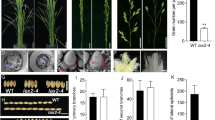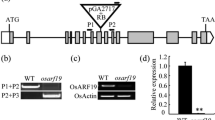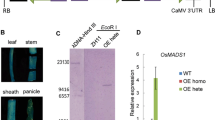Abstract
OSH6 (Oryza sativa Homeobox6) is an ortholog of lg3 (Liguleless3) in maize. We generated a novel allele, termed OSH6-Ds, by inserting a defective Ds element into the third exon of OSH6, which resulted in a truncated OSH6 mRNA. The truncated mRNA was expressed ectopically in leaf tissues and encoded the N-terminal region of OSH6, which includes the KNOX1 and partial KNOX2 subdomains. This recessive mutant showed outgrowth of bracts or produced leaves at the basal node of the panicle. These phenotypes distinguished it from the OSH6 transgene whose ectopic expression led to a “blade to sheath transformation” phenotype at the midrib region of leaves, similar to that seen in dominant Lg3 mutants. Expression of a similar truncated OSH6 cDNA from the 35S promoter (35S::ΔOSH6) confirmed that the ectopic expression of this product was responsible for the aberrant bract development. These data suggest that OSH6-Ds interferes with a developmental mechanism involved in bract differentiation, especially at the basal nodes of panicles.







Similar content being viewed by others
Explore related subjects
Discover the latest articles and news from researchers in related subjects, suggested using machine learning.Abbreviations
- kn1:
-
Knotted1
- KNOX:
-
KNOTTED1-like homeobox
- lg3:
-
Liguleless3
- OSH6:
-
Oryza sativa Homeobox6
- TALE HD:
-
Three amino acid loop extension homeodomain
References
Balcells L, Modolell J, Ruiz-Gómez M (1988) A unitary basis for different Hairy-wing mutations of Drosophila melanogaster. EMBO J 7:3899–3906
Barkan A, Martienssen RA (1991) Inactivation of maize transposon Mu suppresses a mutant phenotype by activating an outward-reading promoter near the end of Mu1. Proc Natl Acad Sci USA 88:227–236
Barton MK, Poethig RS (1993) Formation of the shoot apical meristem in Arabidopsis thaliana—an analysis of development in the wild type and in the shoot meristemless mutant. Development 119:823–831
Bellaoui M, Pidkowich MS, Samach A, Kushalappa K, Kohalmi SE, Modrusan Z, Crosby WL, Haughn GW (2001) The Arabidopsis BELL1 and KNOX TALE homeodomain proteins interact through a domain conserved between plants and animals. Plant Cell 13:2455–2470
Byrne M, Timmermans M, Kidner C, Martienssen RA (2001) Development of leaf shape. Curr Opin Plant Biol 4:38–43
Campuzano S, Balcells L, Villares R, Carramolino L, Garcia-Alonso L, Modolell J (1986) Excess function hairy wing mutations caused by gypsy and copia insertions within structural genes of the achaete-scute locus of Drosophila. Cell 44:303–312
Chen JJ, Janssen BJ, Williams A, Sinha N (1997) A gene fusion at a homeobox locus: alterations in leaf shape and implications for morphological evolution. Plant Cell 8:1277–1289
Chin HG, Choe MS, Lee S-H, Park SH, Park SH, Koo JC, Kim NY, Lee JJ, Oh BG, Yi GH, Kim SC, Choi HC, Cho MJ, Han C-d (1999) Molecular analysis of rice plants harboring an Ac/Ds transposable element-mediated gene trapping system. Plant J 19:615–624
Chuck G, Lincoln C, Hake S (1996) BP induces lobed leaves with ectopic meristems when overexpressed in Arabidopsis. Plant Cell 8:1277–1289
Coen ES, Robbins TP, Almeida J, Hudson A, Carpenter R (1989) Consequences and mechanisms of transposition in Antirrhinum majus. In: Berg DE, Howe MM (Eds) Mobile DNA. American Society of Microbiology, USA, pp 413–436
Copeland JW, Nasiadka A, Dietrich BH, Krause HM (1996) Patterning of the Drosophila embryo by a homeodomain-deleted Ftz polypeptide. Nature 379:162–165
de Folter S, Immink RGH, Kieffer M, Parˇenicova´ L, Henz SR, Weigel D, Busscher M, Kooiker M, Colombo L, Kater MM, Davies B, Angenent GC (2005) Comprehensive interaction map of the Arabidopsis MADS box transcription factors. Plant Cell 17:1424–1433
Freeling M (1992) A conceptual framework for maize leaf development. Dev Biol 153:44–58
Freeling M, Bertrand-Garcia R., Sinha N (1992) Maize mutants and variants altering developmental time and their heterochronic interactions. BioEssays 14:227–236
Greene B, Walko R, Hake S (1994) Mutator insertions in an intron of the maize knotted1 gene result in dominant suppressible mutations. Genetics 138:1275–1285
Goodrich J, Puangsomlee P, Martin M, Long D, Meyerowitz EM, Coupland G (1997) A polycomb-group gene regulates homeotic gene expression in Arabidopsis. Nature 386:44–51
Hake S, Vollbrecht E, Freeling M (1989) Cloning Knotted, the dominant morphological mutant in maize using Ds2 as a transposon tag. EMBO J 8:15–22
Hiei Y, Ohta S, Komari T, Kumashiro T (1994) Efficient transformation of rice (Oryza sativa L.) mediated by Agrobacterium and sequence analysis of the boundaries of the T-DNA. Plant J 6:271–282
Hiratsu K, Mitsuda N, Matsui K, Ohme-Takagi M (2004) Identification of the minimal repression domain of SUPERMAN shows that the DLELRL hexapeptide is both necessary and sufficient for repression of transcription in Arabidopsis. Biochem Biophys Res Commun 321:172–178
Hoshikawa K (1989) The growing rice plant—an anatomical monograph. 1st edn. Nobunkyo, Tokyo
Itoh JI, Hasegawa A, Kitano H, Nagato Y (1998) A recessive heterochronic mutation, plastochron1, shortens the plastochron and elongates the vegetative phase in rice. Plant Cell 10:1511–1522
Kawakatsu T, Itoh JI, Miyoshi K, Kurata N, Alvarez N, Veit B, Nagato Y (2006) PLASTOCHRON2 regulates leaf initiation and maturation in rice. Plant Cell 18:612–625
Kerstetter R, Vollbrecht E, Lowe B, Veit B, Yamaguchi J, Hake S (1994) Sequence analysis and expression patterns divide the maize knotted1-like homeobox genes into two classes. Plant Cell 6:1877–1887
Kerstetter RA, Laudencia-Chingcuanco D, Smith LG, Hake S (1997) Loss-of-function mutations in the maize homeobox gene, knotted1, are defective in shoot meristem maintenance. Development 124:3045–3054
Kim CM, Piao HL, Park SJ, Chon NS, Je BI, Sun B–Y, Park SH, Park JY, Lee EJ, Kim MJ, Chung WS, Lee KH, Lee YS, Lee JJ, Won YJ, Lee GH, Nam MH, Cha YS, Yun DW, Eun MY, Han C-d (2004) Rapid, large-scale generation of Ds transposant lines and analysis of the Ds insertion sites in ride. Plant J 39:252–263
Kouchi H, Hata S (1993) Isolation and characterization of novel nodulin cDNAs representing genes expressed at early stages of soybean nodule development. Mol Gen Genet 238:106–119
Kubli E (1986) Molecular mechanisms of suppression in Drosophila. Trends Genet 2:204–209
Lippman Z, Gendrel A-V, Black M, Vaughn MW, Dedhia N, McCombie WR, Lavine K, Mittal V, May B, Kasschau KD, Carrington JC, Doerge RW, Colot V, Martienssen R (2004) Role of transposable elements in heterochromatin and epigenetic control. Nature 430:471–476
Long JA, Moan EI, Medford JI, Barton MK (1996) A member of the KNOTTED class of homeodomain proteins encoded by the STM gene of Arabidopsis. Nature 379:66–69
Lu Q, Kamps MP (1996) Selective repression of transcriptional activators by Pbx1 does not require the homeodomain. Proc Natl Acad Sci USA 93:470–474
Markel H, Chandler J, Werr W (2002) Translational fusions with the engrailed repressor domain efficiently convert plant transcription factors into dominant-negative functions. Nucleic Acids Res 30:4709–4719
Martienssen R, Lippman Z, May B, Ronemus M, Vaughn M (2004) Transposons, tandem repeats, and the silencing of imprinted genes. Cold Spring Harb Symp Quant Biol 69:371–380
Mitsuda N, Seki M, Shinozaki K, Ohme-Takagi M (2005) The NAC transcription factors NST1 and NST2 of Arabidopsis regulate secondary wall thickening and are required for anther dehiscence. Plant Cell 17:2993–3006
Miyoshi K, Ahn BO, Kawakatsu T, Ito Y, Itoh J, Nagato Y, Kurata N (2004) PLASTOCHRON1, a timekeeper of leaf initiation in rice, encodes cytochrome P450. Proc Natl Acad Sci USA 101:875–880
Muehlbauer GJ, Fowler JE, Freeling M (1997) Sectors expressing the homeobox gene liguleless3 iplicate a time-dependent mechanism for cell fate acquisition along the proximal-distal axis of the maize leaf. Development 124:5097–5106
Muehlbauer GJ, Fowler JE, Girard L, Tyers R, Harper L, Freeling M (1999) Ectopic expression of the maize homeobox gene liguleless3 alters cell fates in the leaf. Plant Physiol 119:651–662
Müller K, Romano N, Gerstner O, Garcia-Maroto F, Pozzi C, Salamini F, Rohde W (1995) The barley Hooded mutation caused by a duplication in a homeobox gene intron. Nature 374:727–730
Muller J, Wang Y, Franzen R, Santi L, Salamini F, Rohde W (2001) In vitro interactions between barley TALE homeodomain proteins suggest a role for protein—protein associations in the regulation of Knox gene function. Plant J 27:13–23
Nagasaki H, Sakamoto T, Sato Y, Matsuoka M (2001) Functional analysis of the conserved domains of a rice KNOX homeodomain protein, OSH15. Plant Cell 13:2085–2098
Ohta M, Matsui K, Hiratsu K, Shinshi H, Ohme-Takagi M (2001) Repression domains of class II ERF transcriptional repressors share an essential motif for active repression. Plant Cell 13:1959–1968
Reiser L, Sanchez-Baracaldo P, Hake S (2000) Knots in the family tree: evolutionary relationships and functions of knox homeobox genes. Plant Mol Biol 42:151–166
Sakamoto T, Nishimura A, Tamaoki M, Kuba M, Tanaka H, Iwahori S, Matsuoka M (1999) The conserved KNOX domain mediates specificity of tobacco KNOTTED1-type homeodomain proteins. Plant Cell 11:1419–1432
Sakamoto T, Kamiya N, Ueguehi-Tanaka M, Iwahori S, Matsuoka M (2001) KNOX homeocomain protein directly suppresses the expression of a gibberellin biosynthetic gene in the tobacco shoot apical meristem. Genes Dev 15:581–590
Sato Y, Sentoku N, Miura Y, Hirochika H, Kitano H, Matsuoka M (1999) Loss-of-function mutations in the rice homeobox gene OSH15 affect the architecture of internodes resulting in dwarf plants. EMBO J 18:992–1002
Schneeberger RG, Becraft PW, Hake S, Freeling M (1995) Ectopic expression of the knox homeobox gene rough sheath1 alters cell fate in the maize leaf. Genes Dev 9:2292–2304
Sentoku N, Sato Y, Kurata N, Ito Y, Kitano H, Matsuoka M (1999) Regional expression of the rice KN1-type homeobox gene family during embryo, shoot, and flower development. Plant Cell 11:1651–1664
Sentoku N, Sato Y, Matsuoka M (2000) Overexpression of rice OSH genes induces ectopic shoots on leaf sheaths of transgenic rice plants. Dev Biol 220:358–364
Sheldon CC, Conn AB, Dennis ES, Peacock WJ (2002) Different regulatory regions are required for the vernalization-induced repression of FLOWERING LOCUS C and for the epigenetic maintenance of repression. Plant Cell 14:2527–2537
Shure M, Wessler S, Fedoroff N (1983) Molecular identification and isolation of the Waxy locus in maize. Cell 35:225–233
Sinha NR, Williams RE, Hake S (1993) Overexpression of the maize homeo box gene, KNOTTED-1, causes a switch from determinate to indeterminate cell fates. Genes Dev 7:787–795
Smith LG, Greene B, Veit B, Hake S (1992) A dominant mutation in the maize homeobox gene, Knotted-1, causes its ectopic expression in leaf cells with altered fates. Development 116:21–30
Smith HMS, Boschke I, Hake S (2002) Selective interaction of plant homeodomain proteins mediates high DNA-binding affinity. Proc Natl Acad Sci USA 99:9579–9584
Venglat SP, Dumonceaux T, Rozwadowski K, Parnell L, Babic V, Keller W, Martienssen R, Selvaraj G, Datla R (2002) The homeobox gene BREVIPEDICELLUS is a key regulator of inflorescence architecture in Arabidopsis. Proc Natl Acad Sci USA 99:4730–4735
Vollbrecht E, Veit B, Sinha N, Hake S (1991) The developmental gene Knotted-1 is a member of a maize homeobox gene family. Nature 350:241–243
Weil CF, Wessler SR (1990) The effects of plant transposable element insertion on transcription initiation and RNA processing. Annu Rev Plant Physiol Plant Mol Biol 41:527–552
Williams-Carrier RE, Lie YS, Hake S, Lemaux PG (1997) Ectopic expression of the maize kn1 gene phenocopies the Hooded mutant of barley. Development 124:3737–3745
Yanofsky MF, Ma H, Bowman JL, Drews GN, Feldmann KA, Meyerowitz EM (1990) The protein encoded by the Arabidopsis homeotic gene agamous resembles transcription factors. Nature 346:35–39
Zhong R, Demura T, Ye Z-H (2006) SND1, a NAC domain transcription factor, is a key regulator of secondary wall synthesis in fibers of Arabidopsis. Plant Cell 18:3158–3170
Acknowledgments
This work was supported by a grant (code # CG151) from Crop Functional Genomics Center of the 21st Century Frontier Research Program. This work also was supported by Korea Research Foundation Grant (KRF-2003-015-C00636), BioGreen 21 Program (Rural Development Administration), by Basic Research Fund (NIAB, 06-2-12-7-1), and from the KOSEF/MOST to the Environmental Biotechnology National Core Research Center (R15-2003-012-01001-0). Sung Han Park, Byoung Il Je, Soon Ju Park, and Hai Long Piao are recipients of fellowships of the Brain Korea21 project. We appreciate very much the comments of Dr. David Jackson at the Cold Spring Harbor Lab (USA).
Author information
Authors and Affiliations
Corresponding authors
Electronic supplementary material
Below is the link to the electronic supplementary material.
Supplementary Fig. 1 Comparison of
OSH6-Ds mRNA levels between mutants (m/m) and ones (OSH6, m/m) expressing 35S::OSH6 by RT-PCR. RT-PCR analysis was performed to detect the mRNAs of OSH6-Ds (m/m) and 35S::OSH6 (OSH6) in plants of single and double genetic combinations. OSH6-Ds transcripts were examined by RT-PCR using the primer pair 3-4/5-2 shown in Fig. 4a. OSH6 mRNA from 35S::OSH6 was detected using a primer pair 3F/3R shown in Fig. 3a. The locations of these primer sets are shown in Fig. 3a. Actin mRNA was used as a control (TIFF 970 kB)
Supplementary Fig. 2 Phenotypic comparisons of panicle nodes in mutant plants (m/m) expressing
OSH6-Ds and in plants (OSH6, m/m) expressing 35S-OSH6 and OSH6-Ds. Pancle nodes are shown in mature plants of wild type, OSH6-Ds, 35S-OSH6, and OSH-Ds/3 5S-OSH6 plants. Arrows indicate ‘bract-leaf’ (TIFF 3.51 MB)
Rights and permissions
About this article
Cite this article
Park, S.H., Kim, C.M., Je, B.I. et al. A Ds-insertion mutant of OSH6 (Oryza sativa Homeobox 6) exhibits outgrowth of vestigial leaf-like structures, bracts, in rice. Planta 227, 1–12 (2007). https://doi.org/10.1007/s00425-007-0576-1
Received:
Accepted:
Published:
Issue Date:
DOI: https://doi.org/10.1007/s00425-007-0576-1




